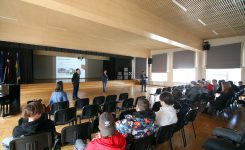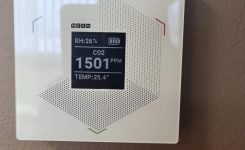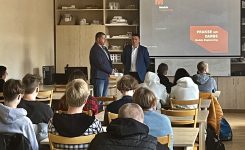2022
“MODULS ENGINEERING” SIGNS AN AGREEMENT WITH THE MINISTRY OF EDUCATION AND SCIENCE
“Before installing the monitors, each building is inspected in order to establish the technical conditions for their installation in each particular case. Only then does the installation of monitors begin, which shall be completed within 40 business days after the signing of the contract with the relevant municipality. Considering the total number of buildings and premises where sensors have to be installed, at the moment the last updates are being made regarding the buildings where the sensors have to be installed and their installation scope. For example, it is related to repair works of school buildings, where objectively no sensors can be installed at the moment”, explained Kaspars Grīniņš, Board member of “Moduls Engineering”.
Main benefits of CO2 monitors
The main purpose of carbon dioxide (CO2) air quality monitors is to report an increased level of CO2 in the room, indicating the necessity to ventilate the room and thus improve air quality and reduce the risks of spreading Covid-19. CO2 is the component of human exhalation that has the biggest impact on air quality, but indoor airborne viruses and bacteria are also released and accumulate with exhalation. The easiest and most efficient way to control the airborne spread of viruses is to measure the CO2 level as it indicates insufficient air exchange.
Monitors also play an important role in assessing the overall performance of the ventilation system, allowing informed and data-driven decisions to be made on the best solution for upgrading the ventilation system. Perhaps, cleaning or balancing of the existing ventilation system will be enough in some cases.
By accumulating historical measurement data, CO2 air monitors serve as a diagnostic tool to aid the assessment of the conformity of the existing ventilation system for the load and functions of the premises. The analysis of the data allows one to identify where the air quality is the worst and where the problem of air exchange needs to be solved acutely, thus characterising exactly what air exchange capacity is needed to ensure that the ventilation built is sufficient without incurring unnecessary operating costs.
Operating principle of CO2 monitors
The air quality monitors offered by “Moduls Engineering” can be connected to the existing mechanical ventilation units, thus ensuring continuous operation according to the actual ventilation demand. In the case of centralised ventilation, these monitors can also be used and, subject to approval of such a solution on a case-by-case basis, municipalities will be able to ensure the efficient use of energy resources and savings.
Modern ventilation units are able to recover roughly 80% of the heating energy; nevertheless, the loss of 20% is significant in the event of public buildings, where complete air exchange is ensured 3 times per hour. This is the reason for the development of smart sensor solutions, enabling dynamic control of the ventilation power in the building according to the load of the premises.
Energy savings are achieved because the ventilation units automatically switch on when the CO2 sensor detects elevated CO2 levels. The air is exchanged in premises with mechanical ventilation and the ventilation units may reduce their operation power or switch off. Whereas, if there is no data on the CO2 level, the ventilation units are operating continuously at the set optimum ventilation mode, without analysing whether the air exchange is sufficient or exceeded. Running ventilation units at lower or lower power levels results in significant long-term energy savings and improved comfort levels for occupants.
The sensor network offered by “Moduls Engineering” uses complex algorithms, which are able to characterise the common state of the building and use mechanical ventilation for ventilating most of the building. The system will provide an alert of the need for additional ventilation in rooms with higher pollution by opening a window, as it is not always cost-effective to re-ventilate the whole building. Modern technologies allow one to automatically make such decisions every minute, ensuring the comfortable and energy efficient use of premises.
The monitor will provide an alert of an increased CO2 level in the room with a light or sound signal, or any other solution better suited to the customer, which can be adjusted according to the preferences of the users in each given situation. In addition to the existing set of monitors, in each individual case, according to the room configuration, area or other customer needs, it will be possible, for example, to install additional sensors, to connect sensors to existing ventilation equipment or to apply other solutions.
Collection and analysis of measurement data
In addition to CO2 concentration, the installed sensors will collect and accumulate temperature and humidity measurements. The measured data will be stored on the server that will be accessible in accordance with the needs of the Ministry of Education and Science and the municipalities. If necessary, it will be possible to transfer data to other systems as well, where it can be used and published as required.
About “Moduls Engineering”
“Moduls Engineering” is part of the AS “MN Holding” corporate group. 2022 marks the 28th year of operation of the company. During these years, the company has grown from a luminaire trader to one of the leading construction companies in the segment of engineering-technical and electrical-technical networks.









